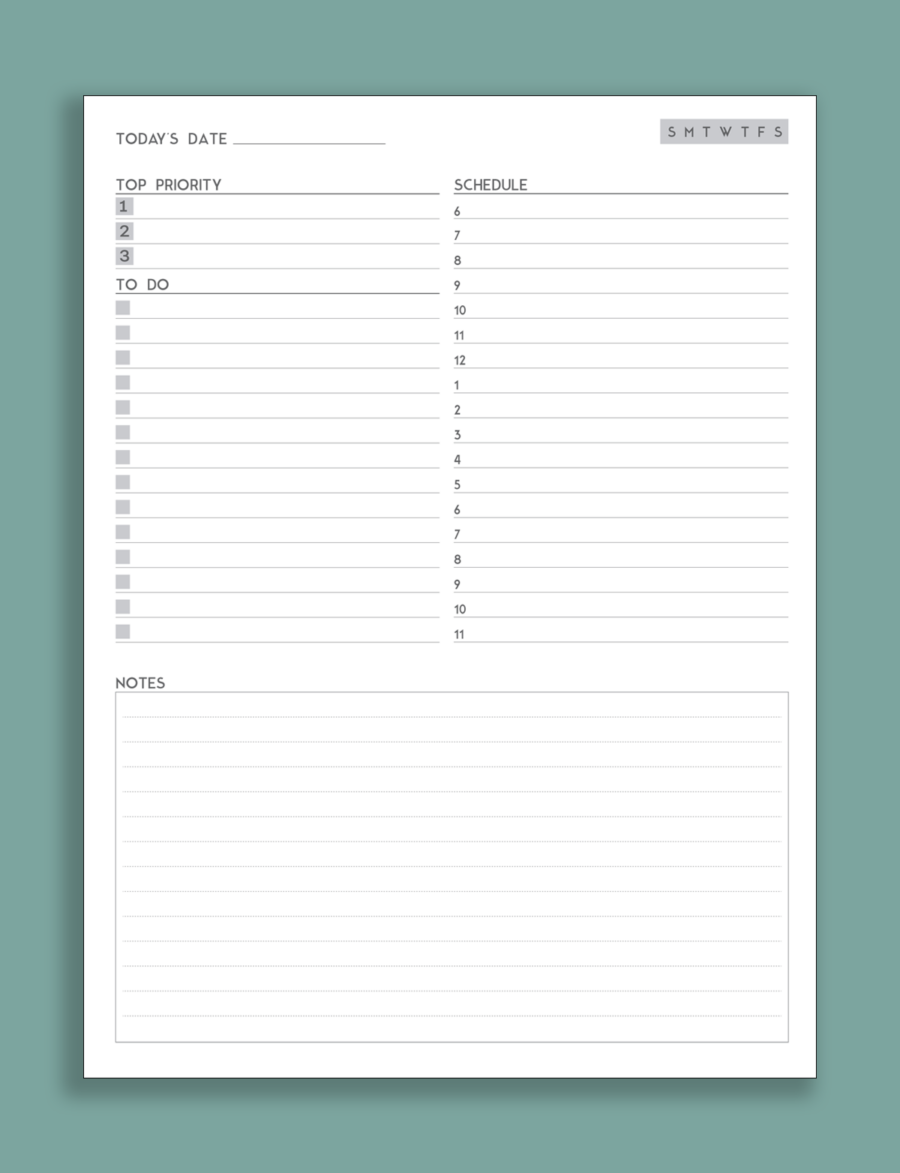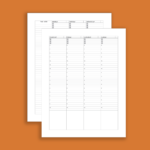Daily Planner
This daily planner is perfect for people who need a full page dedicated to every day.
With a minimal design, this daily plan template gives you just enough guidance to set out your top priorities, schedule the hours in your day, set up a to-do list, and provide a notes section underneath for journaling, reflecting, gratitude, or whatever else you may need.
Below are the instant download links for the daily planning PDF template in various sizes.
Daily Planner Download Links:
- Letter Size – Single Page
- Letter Size – Two-Sided (for 3-Ring Binders)
- Half Letter Size – Two-Sided (for 3-Ring Mini-Binders)
- A5 – Two-Sided (for A5 6-Ring Binders)
- Happy Planner Size – 7″ x 9.25″ – Two-Sided
Most planners come in either a weekly format or daily format. Weekly planners will put the entire week on a page or two, and you fill in your schedule, to-do list, notes, everything on a smalls section of a page.
Daily planning is different and allows for you to set the priorities for the entire day on a single page.
This works well for people who desire a bit more structure in their days, really want to hone in on what’s important, and want to block their available time to be the most productive and have the most fulfilling day possible.
Letter Size Daily Template
This is the most standard paper you likely already own, letter size (8.5″ x 11″).
There are two versions, the Single Page and the Two-Sided version.
The single page is if you want to print your daily planner in a simple stack and leave it on your desk, accessible and requiring nothing else.
The two-sided version is for when you either have pre-punched paper or will punch holes yourself to put in a 3-ring binder.
If your printer can print on both sides of your paper, you can use the two-sided template to print a binder full of daily planning templates in a single printing job.
A5 Daily Template
A5 is a popular size for people who enjoy making DIY organizers with A5 6-ring binders.
A5 paper is a bit wider (5.8″ x 8.3″) than half-letter paper (5.5″ x 8.5″), giving it a small portable space to write while not feeling too narrow and cramped.
Many online binder options exist for 6-ring binders, making it a popular choice.
With pre-punched A5 paper and a printer capable of two-sided printing, you can print weeks’ worth of daily plans in a single printing job for your personal planner.
Half-letter Daily Template
Half-letter is a piece of standard letter paper cut in half.
Half-letter comes in at 5.5″ x 8.5″.
It’s a great DIY option for people who want to take standard paper, cut it in half, and then hole-punch themselves for 3-ring mini-binders to make a DIY planner.
Of course, if you don’t want to go through the trouble of cutting and hole punching, there’s 3-hole pre-punched half-letter paper to make it easier.
Some people prefer 3-ring mini-binders over A5 6-ring binders because of the availability and affordability of popular mini-binders from Avery. Still, they are a bit lacking in style compared to all the A5 options on the Internet.
Happy Planner Daily Template
The Happy Planner is a very popular planner with endless variability in theme and style.
The size of Happy Planner pages, 7″ x 9.25″, is a perfect fit for people who find half-letter and A5 sizes too small but still want some portability.
Happy Planners usually come in weekly formats, so if you want the precision of a daily planning template, you can print this one out and punch the holes yourself.
Breakdown of the Daily Planning Template
Today’s Date
Being an undated daily template, you fill out what day it is for each and every day.
I prefer undated vs. dated for daily planning templates because if you miss a day, you haven’t wasted a sheet of paper and can continue pick it back up without being sad that you have wasted pages.
Day of the Week
This minimal, simple section in the top right corner lets you circle which day of the week.
Top Priority
A to-do list isn’t very useful unless you have a few dedicated lines to prioritize your top 1 or 3 most important things.
To Do
After you set your priorities, keep your remaining tasks below to become a priority another day.
Schedule
A simple and minimal schedule section to block out time in the day.
Set your study hours, meeting reminders, times to get together with others, time to relax and unwind, whatever you need.
Notes
Since this is a minimal template, I didn’t want to bog anyone down with dedicated sections for gratitude, meal tracking, reflection, etc.
Instead, this notes section can be a free-form for whatever you want.




